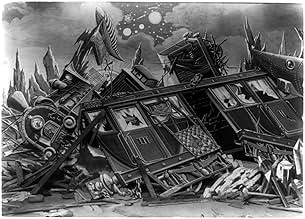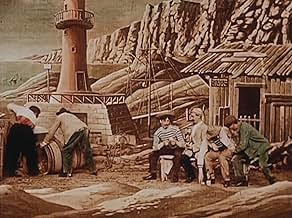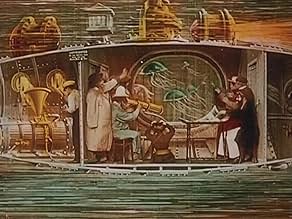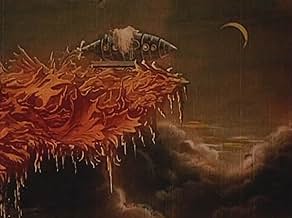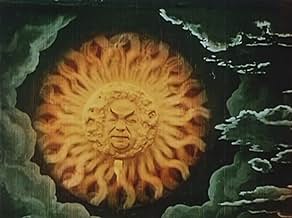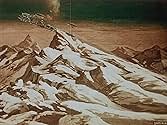IMDb रेटिंग
7.4/10
4.3 हज़ार
आपकी रेटिंग
अपनी भाषा में प्लॉट जोड़ेंUsing every known means of transportation, several savants from the Geographic Society undertake a journey through the Alps to the Sun which finishes under the sea.Using every known means of transportation, several savants from the Geographic Society undertake a journey through the Alps to the Sun which finishes under the sea.Using every known means of transportation, several savants from the Geographic Society undertake a journey through the Alps to the Sun which finishes under the sea.
- निर्देशक
- लेखक
- स्टार
Fernande Albany
- Madame Latrouille
- (बिना क्रेडिट के)
Jehanne d'Alcy
- Villager at seaport
- (बिना क्रेडिट के)
May de Lavergne
- Nurse in Swiss hospital
- (बिना क्रेडिट के)
फ़ीचर्ड समीक्षाएं
I suppose you could consider this film as a spiritual follow up to A Trip to the Moon. The latter remains George Méliès most famous and iconic film; probably for good reason considering its ambition and imagination. An Impossible Voyage explores similar territory and is certainly a worthy companion-piece as an example of early cinematic science fiction.
In this one a group of scientists don't go to the moon, they head further afield to the sun. Perhaps this illustrates Méliès reaching out further too. Certainly this is another example of him developing the idea of what cinema could be. Unlike most of his peers, he was taking the medium into the story-telling sphere. Films like this were in this sense the beginnings of modern cinema as we know it.
The film features a nice colour tint that adds a great deal to the fantastical look. It contains a number of hand painted sets that gives it all a highly stylised look. The scientists' adventure not only takes them to the sun but also across the mountains of Switzerland, which Méliès also depicts like an alien landscape. The travellers end up in the bottom of the ocean completing their amazing journey. All in all this is an entertaining and highly imaginative work, well worth catching.
In this one a group of scientists don't go to the moon, they head further afield to the sun. Perhaps this illustrates Méliès reaching out further too. Certainly this is another example of him developing the idea of what cinema could be. Unlike most of his peers, he was taking the medium into the story-telling sphere. Films like this were in this sense the beginnings of modern cinema as we know it.
The film features a nice colour tint that adds a great deal to the fantastical look. It contains a number of hand painted sets that gives it all a highly stylised look. The scientists' adventure not only takes them to the sun but also across the mountains of Switzerland, which Méliès also depicts like an alien landscape. The travellers end up in the bottom of the ocean completing their amazing journey. All in all this is an entertaining and highly imaginative work, well worth catching.
This is a crazy, delightful mess. Explorers make an effort to go to lands never seen and report back. They try to use every conceivable vehicle to go over mountains, under seas, through outer space, actually visiting the sun (I wonder if they went at night so they wouldn't get burned). There are laughs galore because the stuffed shirt explorers were in no way equipped to do any kind of huge investigation. No matter what horrible things happen to them, getting frozen, blown up, crashing from a hundred miles away, going through the sun, and on and on, they always make their way out. One of the stars of this film is the painted scenery. Melies really liked the jagged edges of the mountains and wacky surreal realms of the outer world.
Having produced a blockbuster in 1903 in which a group of scientists journeyed to the moon, Melies tried to outdo himself the following year by having another group of manic scientists travel to the sun. He made this film longer and stencilled it in colour, and the outcome is quite astounding. To think that Melies was producing lengthy masterpieces like this while contemporary filmmakers were still experimenting with one-shot narratives goes to show how far ahead of his time Melies really was - which makes his downfall less than a decade later all the sadder. Melies fills the screen with colour with sets sometimes similar to the expressionist sets of the German masterpieces of the late teens and 20s, and fills it also with movement. Not one moment passes when there isn't something to look at. Although this film is not as widely known as Le Voyage dans la lune for my money it surpasses it in terms of exuberance and imagination.
In 1895, a stage magician named Georges Méliès witnessed how the Lumière brothers changed the history of entertainment when he attended the first public screening of their projected motion pictures, and was marveled at the idea of moving images. Seven years and dozens of short films later, Méliès was a successful filmmaker on his own account, releasing a movie that would become legendary, "Le Voyage Dans La Lune" ("A Trip to the Moon"), a monumental achievement in which he would finally prove that cinema was more than documentaries and "gimmick films", and that there was something that the Lumières couldn't see: that it was a natural medium for telling stories. So, after having great success with "Le Voyage Dans La Lune", Méliès prepared his next major project as another adaptation of a Jules Verne story: "Le Voyage à Travers l'impossible", or "The Voyage Through the Impossible".
Better known as "The Impossible Voyage", "Le Voyage à Travers l'impossible" is the story of a geographic society (presumably French), which decides to make the ultimate trip. As one can imagine, this won't be a normal voyage, as they will use every vehicle they can use in an attempt to travel across every corner of the world. So, with this in mind, they prepare a train at the Swiss Alps with their advanced machinery and begin their journey. However, first they must arrive to the train, so they use "The Impossible Carriage" to get across the mountains, and after several difficulties, manage to get to the train. With their specially equipped train, the group manages to fly high in the sky, and are literally swallowed by the Sun. The group will face more difficulties, as their voyage will take them to many fantastic places, from the Sun to even the bottom of the Ocean.
The film's source, "Le Voyage à Travers l'impossible", was a play written collaboratively by Jules Verne and French dramatist Adolphe d'Ennery in 1882, in which the writers adapted to stage the style and themes that Verne had been used in his popular novels. Naturally, Méliès' adaptation lacks the benefits of having dialogs, but his version of "The Impossible Voyage" does keep the same atmosphere of Jules Verne's literary work, capturing the spirit of science fiction in each act of the film and mixing it with that magical fantasy and charmingly whimsical humor that Méliès used to employ in each one of his films. With a runtime of only 24 minutes (something unheard of at the time of its release), "The Impossible Voyage" shows a progression of what Méliès did in "A Trip to the Moon", as the narrative is built in a tighter way (despite the similarities with that previous masterpiece).
As usual in a film by Georges Méliès, the real magic of the movie lays in the extremely clever and detailed way in which Méliès creates his special effects, and in the beautiful art direction he uses to make his fantasy come alive. The world of "The Impossible Voyage" seems like a more detailed trip to the same universe of "A Trip to the Moon", where insanely courageous scientists and inventors use their wonderful and crazy machines to conquer the limits of their fantastic world. In this there's a difference with Verne, as while in the writer's novels there's always a certain factuality in his devices, Méliès versions have more of magical than scientific, which goes perfectly with the comedic tone he uses in his adventure films. A magician until the end, Méliès creates wonderful special effects using every single photographic trick he had discovery at the time (there's a wonderful use of miniatures in the movie).
While the legendary classic "Le Voyage Dans La Lune" is certainly an iconic masterpiece (it'll always be Méliès' most famous work), personally I found "Le Voyage à Travers l'impossible" to be a superior film. Maybe it was that I saw it hand-tinted (which gives it an even more beautiful look) or the fact that it gave me the feeling that in this movie Méliès just let his creativity run completely free, but I just enjoyed this one (a bit) more. True, it's a bit tacky for our standards, but even today it holds up surprisingly well and remains as fun as when it was originally done, more than a century ago. "Le Voyage à Travers l'impossible", or "The Impossible Voyage", definitely makes a perfect companion piece to "Le Voyage Dans La Lune", and it's a nice introduction to the magic of Georges Méliès, the Cinemagician.
10/10
Better known as "The Impossible Voyage", "Le Voyage à Travers l'impossible" is the story of a geographic society (presumably French), which decides to make the ultimate trip. As one can imagine, this won't be a normal voyage, as they will use every vehicle they can use in an attempt to travel across every corner of the world. So, with this in mind, they prepare a train at the Swiss Alps with their advanced machinery and begin their journey. However, first they must arrive to the train, so they use "The Impossible Carriage" to get across the mountains, and after several difficulties, manage to get to the train. With their specially equipped train, the group manages to fly high in the sky, and are literally swallowed by the Sun. The group will face more difficulties, as their voyage will take them to many fantastic places, from the Sun to even the bottom of the Ocean.
The film's source, "Le Voyage à Travers l'impossible", was a play written collaboratively by Jules Verne and French dramatist Adolphe d'Ennery in 1882, in which the writers adapted to stage the style and themes that Verne had been used in his popular novels. Naturally, Méliès' adaptation lacks the benefits of having dialogs, but his version of "The Impossible Voyage" does keep the same atmosphere of Jules Verne's literary work, capturing the spirit of science fiction in each act of the film and mixing it with that magical fantasy and charmingly whimsical humor that Méliès used to employ in each one of his films. With a runtime of only 24 minutes (something unheard of at the time of its release), "The Impossible Voyage" shows a progression of what Méliès did in "A Trip to the Moon", as the narrative is built in a tighter way (despite the similarities with that previous masterpiece).
As usual in a film by Georges Méliès, the real magic of the movie lays in the extremely clever and detailed way in which Méliès creates his special effects, and in the beautiful art direction he uses to make his fantasy come alive. The world of "The Impossible Voyage" seems like a more detailed trip to the same universe of "A Trip to the Moon", where insanely courageous scientists and inventors use their wonderful and crazy machines to conquer the limits of their fantastic world. In this there's a difference with Verne, as while in the writer's novels there's always a certain factuality in his devices, Méliès versions have more of magical than scientific, which goes perfectly with the comedic tone he uses in his adventure films. A magician until the end, Méliès creates wonderful special effects using every single photographic trick he had discovery at the time (there's a wonderful use of miniatures in the movie).
While the legendary classic "Le Voyage Dans La Lune" is certainly an iconic masterpiece (it'll always be Méliès' most famous work), personally I found "Le Voyage à Travers l'impossible" to be a superior film. Maybe it was that I saw it hand-tinted (which gives it an even more beautiful look) or the fact that it gave me the feeling that in this movie Méliès just let his creativity run completely free, but I just enjoyed this one (a bit) more. True, it's a bit tacky for our standards, but even today it holds up surprisingly well and remains as fun as when it was originally done, more than a century ago. "Le Voyage à Travers l'impossible", or "The Impossible Voyage", definitely makes a perfect companion piece to "Le Voyage Dans La Lune", and it's a nice introduction to the magic of Georges Méliès, the Cinemagician.
10/10
What an interesting and unusual little feature this is - the combination of Méliès and Jules Verne always produces something worth seeing, and this one is based on one of Verne's most fantastical ideas. It follows a group of scientists and scholars on a very fanciful trip that uses every imaginable form of conveyance, and the story gives Méliès all kinds of opportunities for his trademark visual effects.
Each scene is packed with details, so much so that you cannot even catch it all in one viewing. It is also color-tinted in many places, which adds even more to the effect. The story is just wild, and is less plausible than many Verne stories, but that does not detract from it as entertainment. Méliès even tosses in a little slapstick, which is not too bad for its time. It is similar to, and just a cut below, his film of Verne's "Trip to the Moon", and anyone who enjoyed that classic should also like this one.
Each scene is packed with details, so much so that you cannot even catch it all in one viewing. It is also color-tinted in many places, which adds even more to the effect. The story is just wild, and is less plausible than many Verne stories, but that does not detract from it as entertainment. Méliès even tosses in a little slapstick, which is not too bad for its time. It is similar to, and just a cut below, his film of Verne's "Trip to the Moon", and anyone who enjoyed that classic should also like this one.
क्या आपको पता है
- ट्रिवियाIncluded in the "Georges Melies: First Wizard of Cinema (1896-1913)" DVD collection, released by Flicker Alley.
- गूफ़For a few seconds, a pole can clearly be seen holding the anthropomorphic sun up.
- इसके अलावा अन्य वर्जनAlso available in a computer colorized version.
टॉप पसंद
रेटिंग देने के लिए साइन-इन करें और वैयक्तिकृत सुझावों के लिए वॉचलिस्ट करें
विवरण
- रिलीज़ की तारीख़
- कंट्री ऑफ़ ओरिजिन
- भाषाएं
- इस रूप में भी जाना जाता है
- An Impossible Voyage
- फ़िल्माने की जगहें
- उत्पादन कंपनियां
- IMDbPro पर और कंपनी क्रेडिट देखें
बॉक्स ऑफ़िस
- बजट
- FRF 37,500(अनुमानित)
- चलने की अवधि24 मिनट
- रंग
- ध्वनि मिश्रण
- पक्ष अनुपात
- 1.33 : 1
इस पेज में योगदान दें
किसी बदलाव का सुझाव दें या अनुपलब्ध कॉन्टेंट जोड़ें

टॉप गैप
By what name was Le voyage à travers l'impossible (1904) officially released in India in English?
जवाब
